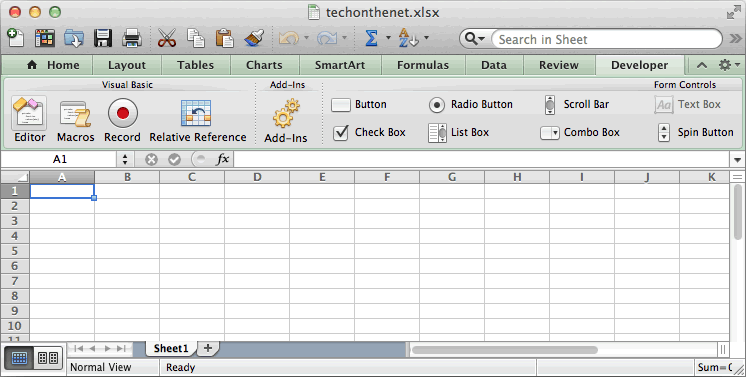Linx is low code tool to build and automate backend applications and web services. PL/SQL Developer by IFS Allround Automations is a feature-rich Integrated Development Environment (IDE) that was designed to help users develop units for Oracle databases using PL/SQL programming. Sadly, there is no version of PL/SQL Developer for Mac, but there are some other tools.
- Developer Tools For Mac
- Website Development Software Mac
- Developer Tools For Mac
- Developer Tools For Microsoft Edge
There are many ways to open Chrome DevTools, because different users want fast access to differentparts of the DevTools UI.
Open the Elements panel to inspect the DOM or CSS
When you want to inspect a DOM node's styles or attributes, right-click the elementand select Inspect.

Or press Command+Option+C (Mac) orControl+Shift+C (Windows, Linux, Chrome OS).
See Get Started With Viewing And Changing CSS.
Open the Console panel to view logged messages or run JavaScript
Press Command+Option+J(Mac) or Control+Shift+J (Windows, Linux, Chrome OS) tojump straight into the Console panel.
See Get Started With The Console.
Open the last panel you had open

Press Command+Option+I (Mac) orControl+Shift+I.
Open DevTools from Chrome's main menu
Click Customize and control Google Chrome and then select More Tools > Developer Tools.
Auto-open DevTools on every new tab
Open Chrome from the command line and pass the --auto-open-devtools-for-tabs flag.
Mac:
Feedback

Or press Command+Option+C (Mac) orControl+Shift+C (Windows, Linux, Chrome OS).
See Get Started With Viewing And Changing CSS.
Open the Console panel to view logged messages or run JavaScript
Press Command+Option+J(Mac) or Control+Shift+J (Windows, Linux, Chrome OS) tojump straight into the Console panel.
See Get Started With The Console.
Open the last panel you had open
Press Command+Option+I (Mac) orControl+Shift+I.
Open DevTools from Chrome's main menu
Click Customize and control Google Chrome and then select More Tools > Developer Tools.
Auto-open DevTools on every new tab
Open Chrome from the command line and pass the --auto-open-devtools-for-tabs flag.
Mac:
Feedback
NVIDIA® CUDA Toolkit 11.1 Update 1 no longer supports development or running applications on macOS. While there are no tools which use macOS as a target environment, NVIDIA is making macOS host versions of these tools that you can launch profiling and debugging sessions on supported target platforms.
Developer Tools For Mac
You may download all these tools here. Note that the Nsight tools provide the ability to download these macOS host versions on their respective product pages.
Please visit each tool's overview page for more information about the tool and its supported target platforms.
The macOS host tools provided are:
- Nsight Systems - a system profiler and timeline trace tool supporting Pascal and newer GPUs
- Nsight Compute - a CUDA kernel profiler supporting Volta and new GPUs
- Visual Profiler - a CUDA kernel and system profiler and timeline trace tool supporting older GPUs (see installation instructions, below)
- cuda-gdb - a GPU and CPU CUDA application debugger (see installation instructions, below)
Download Revision History NVIDIA® development tools are freely offered through the NVIDIA Registered Developer Program
Instructions for installing cuda-gdb on the macOS
- This tar archive holds the distribution of the CUDA 11.1 Update 1 cuda-gdb cuda-gdb debugger front-end for macOS.
Native macOS debugging is not supported in this release. Remote debugging from a macOS host to other CUDA enabled targets, however, is supported.
Supported Mac platforms: macOS 10.13
- To install:
- Create an installation directory
INSTALL_DIR=$HOME/cuda-gdb-darwin-11.1mkdir $INSTALL_DIRcd $INSTALL_DIR - Download the cuda-gdb-darwin-11.1.105.tar.gz tar archive into
$INSTALL_DIRabove - Unpack the tar archive
tar fxvz cuda-gdb-darwin-11.1.105.tar.gz - Add the bin directory to your path
PATH=$INSTALL_DIR/bin:$PATH - Run cuda-gdb --version to confirm you're picking up the correct binaries
cuda-gdb --version - Double click .dmg file to mount it and access it in finder.
- Drag nvvp folder and drop it to any location you want (say ).
Directory Structure:- |--nvvp
|--bin/
|--lib64/
|--libnvvp/ - Download and install the required version of JDK.
(Refer to the Notes about JRE Requirements when using Visual Profiler on the macOS section, below) - Open terminal.
- Change to the bin folder
> cd /nvvp/bin - Run nvvp script file in command line
> ./nvvp -vm- For example:
> ./nvvp -vm /Library/Java/JavaVirtualMachines/zulu-8.jdk/Contents/Home/jre/bin/java - Remote profiling
- Import nvprof output files
- Download version: 8u144-b01 (Zulu: 8.23.0.3) .dmg.zip.tar.gz
- Download version: Zulu 8.23.0.3 (build 1.8.0_144-b01 .zip
You should see the following output:
- NVIDIA (R) CUDA Debugger
11.1 release
Portions Copyright (C) 2007-2020 NVIDIA Corporation
GNU gdb (GDB) 8.3.1
Copyright (C) 2019 Free Software Foundation, Inc.
License GPLv3+: GNU GPL version 3 or later Website Development Software Mac
Instructions for installing Visual Profiler on the macOS
- Native macOS profiling is not supported in this release. Remote profiling from a macOS host to other CUDA enabled targets, however, is supported.
Supported Mac platforms: macOS 10.13
- Steps to install:
- Steps to run:
- Summary of supported features:
- Refer the 'Visual Profiler' section in the 'Profiler User's Guide'
for more information:
- https://docs.nvidia.com/cuda/profiler-users-guide/index.html#visual
Notes about JRE Requirements when using Visual Profiler on the macOS
Developer Tools For Mac
- OpenJDK provides an open-source (and standards compliant) implementation of a Java compliant JVM.
Binaries are provided by various vendors such as Oracle, Azul Systems (Zulu), Amazon, Red Hat, IBM, etc.
- Visual Profiler needs to use an older version of Java, specifically JRE update 151, to work correctly.
This is currently not offered by Oracle JDK but is provided by Azul Systems (Zulu).
- The Bazel Build project also uses the Zulu builds of OpenJDK.
- Download JDK 8.0.144 to get JRE update 151:
